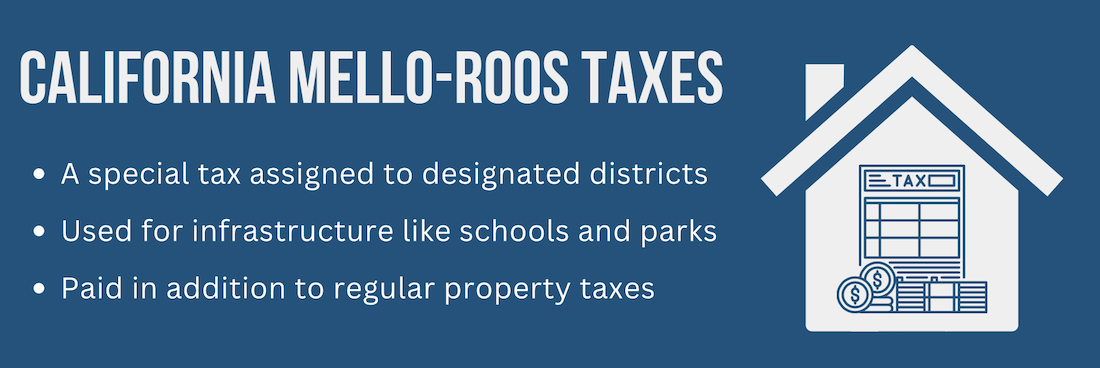Countless articles have been written about the different steps to buying a house. In fact,…
Tips for Buying a Home in a California Mello-Roos District
Summary: In a Mello-Roos district or neighborhood, California homeowners pay additional taxes to fund public infrastructure projects like schools, roads or parks. These neighborhoods often have better infrastructure and services, but with an added tax burden for homeowners.
California has a lot of neighborhoods that are located within Mello-Roos districts. So if you’re planning to buy a home in California, you might encounter this terminology while looking at houses.
But what are Mello-Roos districts exactly? And what are the pros and cons of buying a home in one of these neighborhoods? Those are just a couple of the questions we will answer in this FAQ-based guide for California home buyers.
What Are Mello-Roos Taxes?
Mello-Roos taxes are a special type of tax levied on properties within a designated area called a Community Facilities District (CFD). These taxes are used to fund public infrastructure and services like roads, schools, parks, libraries, police and fire protection.
Not all neighborhoods in California have these additional taxes. So when buying a home, you’ll have to research this for different communities to see if it applies.
How Do They Differ From Regular Property Taxes?
Mello-Roos is separate from your regular property taxes. Here’s a breakdown of the key differences between them.
1. Calculation: Traditional property taxes are based on a percentage of your home’s assessed value. Mello-Roos are not directly tied to your home’s value and are therefore calculated differently (see next question).
2. Purpose: Traditional property taxes go towards a wide range of general government services. In contrast, California Mello-Roos taxes are designated specifically for the development and maintenance of infrastructure and services within the Community Facilities District where you live.
3. Proposition 13: In California, traditional property tax increases are limited by Proposition 13. Mello-Roos taxes were created as a way to work around those restrictions.
How Are Mello-Roos Taxes Calculated?
They can be calculated in several different ways, depending on the Community Facilities District (CFD) where you plan to buy a home. Here are the most common methods:
- Square Footage: The tax is based on the square footage of your home or lot. Larger properties pay more.
Flat Rate: Every property within the district pays the same amount, regardless of size or value.
Other: There can be variations or combinations of these methods.
According to the California Land Title Association:
“Most special taxes levied on properties within these districts have been structured on the basis of density of development, square footage of construction, or flat acreage charges. The Act, however, allows for considerable flexibility in the method of apportionment of taxes, and the local agencies may have established an entirely different method of levying the special tax against property in the district in question.”
If you’re planning to buy a home located within a California Mello-Roos neighborhood, you’ll need to do some research to find out how they’re calculated. The calculation method should be outlined in the disclosure documents relating to the property.
Also, the city or special district responsible for the CFD probably has a website with detailed information about Mello-Roos, including the calculation formula.
How Long Do These Taxes Typically Last?
In California, Mello-Roos taxes typically last for 20 to 25 years but can extend for up to 40 years in some cases. The duration is set when the Community Facilities District is established and is meant to coincide with the time it takes to pay off the bonds that funded the development.
This is another important subject to research, before buying a home in a California Mello-Roos district. The seller’s disclosure might include this information. You can also find it through the county tax assessor’s office or the CFD’s website.
Can They Go Up Over Time?
Yes, Mello-Roos taxes can increase over time, even after you buy a home in the neighborhood. However, there are usually some built-in restrictions that limit increases.
Most Mello-Roos taxes have a maximum annual increase, usually around 2%. This is designed to provide predictability for homeowners. In some cases, the increases are tied to the rising costs of services or inflation.
Be sure to check the specific rules for the Community Facilities District where you’re planning to buy a home. These details should be included in any home purchasing disclosures.
Do They Apply to All Properties in California?
No, not all homes in California have Mello-Roos taxes. They are only applied to homes located within a designated Community Facilities District (CFD). These districts are often associated with newer developments where the additional tax is used to fund initial infrastructure needs.
Can I Deduct Them From My Federal Income Taxes?
In most cases, Mello-Roos taxes are not deductible on federal income tax returns.
The IRS generally only allows deductions for property taxes that are based on your home’s assessed value. And as we explained above, Mello-Roos taxes are calculated differently. They’re not based on your home’s value.
In rare situations, a portion of a homeowner’s Mello-Roos taxes might be deductible if they were used strictly for maintenance or interest charges. To determine this, you would need to consult with a tax professional.
How Can I Find Out if a Home Has Mello-Roos?
As a home buyer, you have several ways to find out if a particular property has Mello-Roos taxes assigned to it.
Real Estate Agent: Your real estate agent is obligated to disclose Mello-Roos taxes and should be able to provide the annual amount as well.
Seller’s Disclosure: The seller is legally required to disclose if the property is within a Community Facilities District. This information should be readily available in the disclosure documents.
County Tax Assessor: Contact the assessor’s office where the property is located. They can provide the official record of any special taxes, including Mello-Roos.
Online Resources: Some California counties offer websites with searchable databases of properties that have Mello-Roos taxes.


